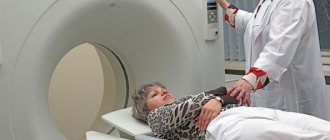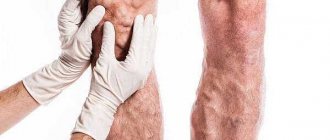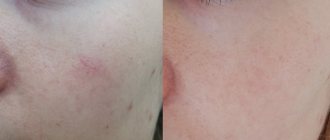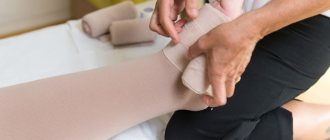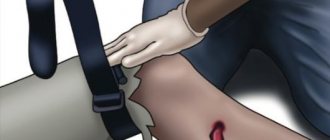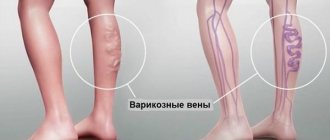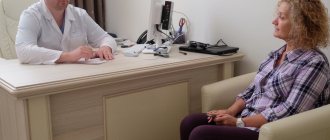Traumatologist-orthopedist
Shelepov
Alexander Sergeevich
12 years of experience
Doctor
Make an appointment
An accumulation of clots or liquid blood in the soft tissues of the body, formed due to rupture of blood vessels, is called a hematoma. The most common type of pathology is an ordinary bruise. However, this concept includes much more severe and complex cases that cannot be left without qualified medical care. Blood flowing from the vessel irritates the tissues surrounding it, resulting in pain, tissue swelling and other signs of developing inflammation. In addition, the hematoma compresses the tissues or organs located next to it, which can lead to the development of complications.
General information
The main cause of hematomas are bruises - closed injuries to soft tissues resulting from a blow or fall. A strong blow leads to rupture of the walls of small blood vessels, due to which blood begins to flow through the breakout sites into the subcutaneous tissue, soft tissues or body cavities. Hematomas form in different parts of the body - on the limbs, torso and even on the head. In addition to bruises, hematomas are caused by intense compression and stretching of tissues due to dislocations or fractures.
Small lesions, as a rule, do not require any treatment and resolve on their own within a few days. When large hematomas form, there is a risk of infection and the development of suppuration. Most often, hematomas form in representatives of younger age groups - children, adolescents and young people, who are characterized by high physical activity. Another “risk group” are people with increased fragility of the vascular wall, as well as with blood clotting disorders.
Diseases that cause bruising
If bruises appear in women without mechanical causes, this may be a signal from the body about the presence of a serious illness. Such diseases include:
- disturbances in the functioning of the endocrine system;
- problems with the heart and blood vessels;
- varicose veins, which provokes multiple formation of hematomas;
- violation of the level of platelets in the blood;
- kidney and urology problems;
- liver diseases;
- high blood pressure;
- rheumatism.
It often happens that during the treatment of one disease, such potent drugs are prescribed that can negatively affect the functioning of other organs.
Frequent studies have confirmed that when using an anti-inflammatory drug called Ibuprofen, many people experienced bruises on their bodies.
There are many other medications, after the use of which, one of the negative consequences may be the destruction of the walls of blood vessels or blood thinning. If a woman notices bruises on her body after taking certain medications, she should stop using it.
Why does a hematoma change color?
Doctors identify three distinct stages of a hematoma through which it must go before completely disappearing. Each of them is characterized by a certain skin color, through which the hemorrhage is visible.
- Appearance of a bruise. Immediately after a soft tissue bruise, a sharp pain is felt, the area of skin in the damaged area becomes purplish-red and swells due to tissue swelling, then the red color gradually changes to blue. The red color comes from red blood cells containing large amounts of hemoglobin. After a few hours, hemoglobin begins to break down, and the bruise site turns blue. Due to swelling and inflammation of the tissue in the damaged area, the temperature rises.
- Greening. After two or three days, swelling and temperature decrease, the condition of the tissues more or less returns to normal, but minor pain when pressed remains. The blue tint of the skin gradually turns into a greenish color.
- Yellowing. By about the fifth day, the swelling completely disappears, the remaining hemoglobin disintegrates and is removed from the tissues. The site of the bruise becomes yellowish, then acquires its normal color.
Visual symptoms of hematomas are most clearly visible in cases where the effusion of blood occurs in the subcutaneous layer. If a clot forms in the deeper layers of soft tissue, then only a small but painful swelling is noticeable on the outside. Such formations are much more dangerous, since the process occurs unnoticed and can be accompanied by complications.
Are you experiencing symptoms of a hematoma?
Only a doctor can accurately diagnose the disease. Don't delay your consultation - call
What is not recommended to do
If we are talking about how to minimize unpleasant consequences and prevent possible complications during treatment at home, then the following rules should not be neglected. For this it is important:
- Refrain from hot baths at least in the first days after injury: hot water accelerates blood flow, which increases inflammation and swelling in the damaged area.
- Reduce motor and physical activity, overcoming pain: this way you can cause even more harm to the diseased joint.
- You should not massage the area next to the injury: this will increase blood circulation, which will result in swelling, and in some cases, bruising may occur.
- Try to avoid too long rest or rest - for the first couple of days it is advisable to refrain from sudden movements and active movements, and already on the third day after a sprain or bruise, you can gradually increase the load (lean on the injured leg), but in the case of fractures or dislocations, the methods and timing of healing Only the attending physician can advise on injuries.
If you follow these simple rules, you can prevent negative consequences from injury, and for preventive purposes, when complete recovery occurs, doctors recommend using comfortable shoes with orthopedic insoles.
Types of damage
The faster a hematoma forms, the more difficult the recovery. Injuries of this type are divided into:
- lungs that develop within a day, accompanied by mild pain and not requiring special treatment;
- moderate severity, the appearance of which requires no more than 5-6 hours, accompanied by noticeable swelling and pain, worsening the motor function of the limb;
- severe, forming within 2 hours after a bruise, accompanied by dysfunction of the limb, acute pain and noticeable swelling.
Treatment of moderate and severe hematomas should be carried out under the supervision of a physician to eliminate possible negative consequences of injury.
In addition to the severity of the damage, there are other criteria for classifying hematomas:
- by depth of location - under the skin, under the mucous membrane, deep in the muscle tissue, under the fascia, etc.;
- according to the state of spilled blood - uncoagulated (fresh), coagulated and lysed (filled with old blood that is not capable of clotting);
- by the nature of blood distribution - diffuse (blood permeates the tissue and spreads quickly), cavitary (blood accumulates in the cavity between the tissues) and encysted (over time, the cavity filled with blood is surrounded by a “bag” of connective tissue);
- according to the condition of the vessel - pulsating (blood flows freely from the vessel and flows back) and non-pulsating (the rupture of the vessel is quickly sealed by a thrombus).
Almost always, hemorrhage poses a health hazard, so to eliminate its consequences, you need to seek medical help immediately after the injury.
Preventing bruises
To avoid having to deal with the causes of bruising on the body at some point, it is important to follow simple rules:
- walk more in the fresh air;
- regularly stretch your legs with a massage, especially in your calves;
- protect yourself from mechanical damage to the skin;
- control your weight and maintain it at a normal level;
- wear high-quality comfortable shoes;
- organize a proper balanced diet, including vitamins necessary for the body;
- monitor your health and conduct a medical examination.
It is recommended to have your health examined once a year if you are feeling well. It is important to be sensitive to your health and, if the slightest signs of pathology occur, diagnose the causes and undergo timely treatment. Proper nutrition and a healthy lifestyle will help maintain health for many years.
Examination methods
To diagnose hematomas, you need to contact a traumatologist. When the hemorrhage is localized deep in muscle tissue, joints or internal organs, a visual examination provides too little information for the doctor to objectively assess the severity of the lesion and the degree of danger of injury. In such situations, the patient is prescribed:
- Ultrasound of a damaged body part, organ or joint;
- X-ray of the damaged part of the body;
- CT or MRI;
- puncture (puncture with a special needle) of a joint or organ in which blood is believed to have accumulated.
Based on the examination results, the doctor prescribes appropriate procedures.
What to do if you are diagnosed with varicose veins
The appearance of the first harbingers of an impending disease requires a more picky attitude towards shoes. It should be as comfortable as possible. It doesn't work equally well here:
- and high heel
- nor flat sole.
So you have to choose something in between. You will also need to reconsider your wardrobe. And exclude from it:
- tight clothes
- tight underwear
which may interfere with normal blood circulation. Knee socks and stockings with elastic bands are also subject to confiscation. They increase congestion in the veins.
While the visible part of the disease is limited only to thin mesh-webs on the skin, you can massage
They will be successfully replaced by products made from compression knitwear, in which everything is thought out and precisely calculated. In the ankle area they fit tightly around the leg, and as you move up the girth gradually weakens. This provides the vessels with additional support, and blood moves freely through the veins. Moreover, modern therapeutic tights, stockings and knee socks, unlike the old ones, are also beautiful. Delicate, transparent and durable, they fit well on the foot.
These products are especially necessary during pregnancy, from the earliest stages. And also when taking hormonal drugs. However, before purchasing things with a compression effect, it does not hurt to consult a phlebologist. He will determine the required size and calculate the pressure required for the therapeutic effect.
What to do:
- Wear therapeutic compression socks, stockings or tights.
- Wear shoes with heels no higher than 6 cm.
- When resting, raise your legs 15 cm above heart level.
- Sunbathe less, relax more in the shade.
- Useful sports: walking, running, swimming, cycling, skiing.
- Pay attention to a sufficient amount of fiber substances in food, such as vegetables, fruits, whole grains and plant foods, which also prevents constipation.
- Drink enough water. Every adult should drink up to two liters of fluid daily, especially during the hot season.
- Try not to wear clothes that restrict movement in your shoulders and hips.
- Take the stairs on foot often. Do not use elevators in office buildings, shopping centers, residential buildings, etc. Walking on stairs has a beneficial effect on the functioning of your venous system.
- Sit correctly. Keep your shoulders as low as possible. Don't cross your legs. Use chairs and chairs with hard surfaces.
- Run in place. If you work while standing a lot, we recommend jogging in place during breaks at work. After performing this exercise, tension is relieved from the veins.
- Avoid heavy lifting and use strollers when shopping. By lifting weights, you create pressure and blood flows down, which puts additional stress on the veins.
- Avoid hot baths and wash your feet with cold water. This will prevent your veins from dilating and will facilitate blood circulation.
- The sun is beneficial for people, but the heat of the sun makes it difficult for the venous system to function. Therefore, rest more in the shade. If possible, try to run barefoot in cold water.
What not to do:
- Avoid warming procedures. They dilate the veins, which increases the load on the vessels.
- It is not recommended to sit in a hot bath. It is better to wash your feet with cool water.
- In order not to increase the number of spider veins on the body, it is advisable to sunbathe less.
- Don't get carried away with the bathhouse. If you have varicose veins, you need to watch your diet. Fats, sugar and salt lead to increased intra-abdominal pressure and constipation. This increases blood flow to the lower extremities. Vegetables, fruits, whole grains and plant products, on the contrary, help soften the contents of the intestines and reduce pressure on the walls of the veins.
Leg exercises for varicose veins
- Support yourself with both hands and, breathing freely, rise onto your tiptoes and then lower onto your heels. Repeat 15-20 times.
- Sitting on a chair. Legs are together and pressed against each other. Consistently lift your feet onto your toes and lower your heels to the floor. Breathing is free. Repeat 15-20 times.
- Place your hands at shoulder height on the wall. Then rise up onto your toes and back down onto your heels. Repeat 15-20 times.
Exercises for feet with varicose veins
"Swallow Pose"
As you inhale, raise your arms up and stand on your toes. As you exhale, stand in the “swallow pose.” Repeat 15-20 times.
Tiptoe exercise
- Stand on tiptoes with both feet. Repeat 15-20 times.
- Alternate movement of the legs from heel to toe. Repeat 15-20 times.
- Standing on your heels. Repeat 15-20 times.
- Movements of the legs to the right, left, in different directions. Repeat 15-20 times.
How to remove hematomas?
After establishing the nature and characteristics of the hematoma, treatment is prescribed in accordance with the information received:
- prescribe UHF procedures;
- a surgical opening is performed to remove accumulated clots and rinse the cavity;
- the patient is hospitalized in the surgical department for opening and drainage, followed by antibiotic therapy.
Recovery time depends on the extent of the lesion, the presence or absence of infection and other factors.
Specialists
| 5.0 143 reviews | Anchikov Grigory Yurievich Phlebologist 40 years of experience Doctor of the highest category Admission from 3180 rub. |
| 4.8 26 reviews | Rumyantsev Andrey Yurievich Phlebologist Experience 26 years Doctor of the highest category Admission from 2500 rub. |
| 4.5 14 reviews | Pustovoit Alexey Alexandrovich Phlebologist Experience 13 years Reception from 4500 rub. |
Frequently asked questions
How to get rid of a hematoma using traditional methods?
Folk remedies only help with minor and non-dangerous superficial damage. To speed up resorption, you can apply a compress of mashed cabbage leaves, bodyagu mixed with Vaseline, or tampons soaked in a mummy solution to the bruise. For deep or extensive injuries, you should consult a doctor.
Why is a hematoma dangerous?
The greatest danger to health, and sometimes to life, are hematomas that form deep in the tissues, inside organs or joints. Large hemorrhage is dangerous due to the possible development of infection, inflammation and suppuration. If the joint is damaged, bursitis, synovitis or hemarthrosis may develop, resulting in disability. Blood in the peritoneal cavity leads to peritonitis. Brain hematomas lead to dysfunction of this organ with serious consequences in the form of deterioration of cognitive functions, paralysis of body parts, etc.
How to treat a hematoma in the first hours after injury?
Immediately after a bruise, it is necessary to provide first aid to the victim: apply ice to the injured area, then tightly bandage the injured limb to block the flow of blood into the tissue. The dressing should not remain on for more than two hours. During this time, it is necessary to get to the emergency room, where the patient will receive the necessary professional help.
Diagnosis of diseases that cause bruising
Timely diagnosis of the causes of bruises on the body will lead to treatment being prescribed and eliminating the problem in a short time. To identify the causes, a blood test is performed to:
- platelets;
- avitaminosis;
- foldability;
- leukocytes;
- hormonal composition.
With a comprehensive analysis of blood composition, you can get a clear picture of the disorders within the body.
So an increased level of leukocytes is a sign of inflammatory processes. Accordingly, it is then necessary to identify the place or organ that has undergone inflammation. An abnormal platelet level indicates a disturbance in the composition of the blood and the possible occurrence of thrombosis.
The lack of the required amount of vitamins and blood clotting explains the deterioration of the structure of the walls of blood vessels. If the blood is too thick, then stagnation is possible, leading to damage to the walls.
Hormonal imbalances in women directly affect the appearance of bruises on the body.
Having determined the true cause of this problem, it is important to start treatment on time. By choosing comprehensive measures to combat the disease, you can quickly return your skin to its ideal appearance.

